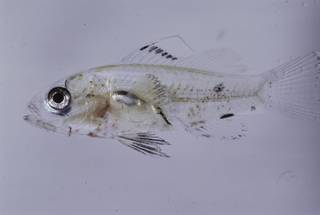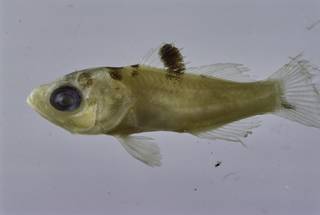WoRMS taxon details
Serranidae Swainson, 1839
- Subfamily Anthiadinae Poey, 1861
- Genus Bullisichthys Rivas, 1971
- Genus Centropristis Cuvier, 1829
- Genus Chelidoperca Boulenger, 1895
- Genus Cratinus Steindachner, 1878
- Genus Dapalis Gistl, 1848 †
- Genus Diplectrum Holbrook, 1855
- Genus Dules Cuvier, 1829
- Subfamily Epinephelinae Bleeker, 1874
- Subfamily Grammistinae Bleeker, 1857
- Genus Hypoplectrus Gill, 1861
- Genus Paralabrax Girard, 1856
- Genus Parasphyraenops Bean, 1912
- Genus Schultzea Woods, 1958
- Genus Serraniculus Ginsburg, 1952
- Subfamily Serraninae Swainson, 1839
- Genus Serranus Cuvier, 1816
- Genus Zalanthias Jordan & Richardson, 1910
- Subfamily Anthiinae Poey, 1861 accepted as Anthiadinae Poey, 1861 (later homonym of Anthiinae Bonelli, 1813 (Coleoptera))
- Genus Aylopon Rafinesque, 1810 accepted as Anthias Bloch, 1792 (synonym)
- Genus Centropristes accepted as Centropristis Cuvier, 1829 (misspelling)
- Genus Doules accepted as Dules Cuvier, 1829 (misspelling)
- Genus Emmelanthias Smith, 1955 accepted as Nemanthias Smith, 1954 (synonym)
- Genus Hemitlutjanus accepted as Hemilutjanus Bleeker, 1876 (misspelling)
- Genus Hepatus Artedi in Röse, 1793 accepted as Serranus Cuvier, 1816
- Genus Hypoplectus accepted as Hypoplectrus Gill, 1861 (misspelling)
- Genus Mikrolabrichthys accepted as Mirolabrichthys Herre, 1927 accepted as Pseudanthias Bleeker, 1871 (misspelling)
- Genus Mirolabrichthys Herre, 1927 accepted as Pseudanthias Bleeker, 1871 (synonym)
- Genus Mirolabrichtys accepted as Mirolabrichthys Herre, 1927 accepted as Pseudanthias Bleeker, 1871 (misspelling)
- Genus Naurua Whitley & Colefax, 1938 accepted as Luzonichthys Herre, 1936 (synonym)
- Genus Neanthias Norman, 1931 accepted as Serranus Cuvier, 1816
- Subfamily Niphoninae Jordan, 1923 accepted as Niphonidae Jordan, 1923 (unaccepted > superseded rank)
- Genus Novanthias Whitley, 1937 accepted as Serranus Cuvier, 1816
- Genus Paracentropristis Klunzinger, 1884 accepted as Serranus Cuvier, 1816
- Genus Pelontrus Smith, 1961 accepted as Plectranthias Bleeker, 1873 (synonym)
- Genus Promicrops Poey (ex Gill), 1868 accepted as Epinephelus Bloch, 1793 (synonym)
- Genus Promoicrops accepted as Promicrops Poey (ex Gill), 1868 accepted as Epinephelus Bloch, 1793 (unaccepted > misspelling - incorrect subsequent spelling)
- Genus Pteranthias Weber, 1913 accepted as Plectranthias Bleeker, 1873 (synonym)
- Genus Schultzetta accepted as Schultzea Woods, 1958 (misspelling)
- Genus Xenanthias Regan, 1908 accepted as Plectranthias Bleeker, 1873 (synonym)
- Genus Ypsigramma Schultz in Schultz, Herald, Lachner, Welander & Woods, 1953 accepted as Liopropoma Gill, 1861 (synonym)
- Genus Serranidarum † (uncertain > unassessed)
marine, brackish, fresh, terrestrial
Not documented
Distribution Distribution: Tropical and temperate oceans. Some enter freshwater. Operculum bearing 3 spines - a main spine with one...
Distribution Distribution: Tropical and temperate oceans. Some enter freshwater. Operculum bearing 3 spines - a main spine with one below and one above it. Lateral line complete and continuous, not reaching onto caudal fin (lacking in one species). Dorsal fin may be notched, with 7-12 spines. Three spines on anal fin. Caudal fin usually rounded, truncate, or lunate; rarely forked. Tip of maxilla exposed even with mouth closed. No scaly axillary pelvic process. One spine on pelvic fin; soft rays 5. Branchiostegal rays usually 7. Vertebrae 24-26. Monoecious with some functional hermaphrodites; groupers are protogynous hermaphrodites. Groupers attain up to 3 m maximum length and weights of up to 400 kg. They are bottom-dwelling predators and highly commercial food fish. [details]
Froese, R. and D. Pauly. Editors. (2024). FishBase. Serranidae Swainson, 1839. Accessed through: World Register of Marine Species at: https://www.marinespecies.org/aphia.php?p=taxdetails&id=125561 on 2024-11-21
Date
action
by
![]() The webpage text is licensed under a Creative Commons Attribution 4.0 License
The webpage text is licensed under a Creative Commons Attribution 4.0 License
taxonomy source
Van Der Laan, R.; Eschmeyer, W. N.; Fricke, R. (2014). Family-group names of Recent fishes. <em>Zootaxa.</em> 3882(1): 1-230., available online at https://doi.org/10.11646/zootaxa.3882.1.1 [details] Available for editors  [request]
[request]
context source (PeRMS) Chirichigno, N.; Cornejo, M. (2001). Catálogo comentado de los peces marinos del Perú. <em>2ª ed. Instituto del Mar de Perú. Publicación Especial. Callao.</em> 314 p. [details]
basis of record van der Land, J.; Costello, M.J.; Zavodnik, D.; Santos, R.S.; Porteiro, F.M.; Bailly, N.; Eschmeyer, W.N.; Froese, R. (2001). Pisces, <B><I>in</I></B>: Costello, M.J. <i>et al.</i> (Ed.) (2001). <i>European register of marine species: a check-list of the marine species in Europe and a bibliography of guides to their identification. Collection Patrimoines Naturels,</i> 50: pp. 357-374 (look up in IMIS) [details]
additional source Fricke, R., Eschmeyer, W. N. & Van der Laan, R. (eds). (2024). ECoF. Eschmeyer's Catalog of Fishes: Genera, Species, References. <em>California Academy of Sciences. San Francisco.</em> Electronic version accessed dd mmm 2024., available online at http://researcharchive.calacademy.org/research/Ichthyology/catalog/fishcatmain.asp [details]
context source (PeRMS) Chirichigno, N.; Cornejo, M. (2001). Catálogo comentado de los peces marinos del Perú. <em>2ª ed. Instituto del Mar de Perú. Publicación Especial. Callao.</em> 314 p. [details]
basis of record van der Land, J.; Costello, M.J.; Zavodnik, D.; Santos, R.S.; Porteiro, F.M.; Bailly, N.; Eschmeyer, W.N.; Froese, R. (2001). Pisces, <B><I>in</I></B>: Costello, M.J. <i>et al.</i> (Ed.) (2001). <i>European register of marine species: a check-list of the marine species in Europe and a bibliography of guides to their identification. Collection Patrimoines Naturels,</i> 50: pp. 357-374 (look up in IMIS) [details]
additional source Fricke, R., Eschmeyer, W. N. & Van der Laan, R. (eds). (2024). ECoF. Eschmeyer's Catalog of Fishes: Genera, Species, References. <em>California Academy of Sciences. San Francisco.</em> Electronic version accessed dd mmm 2024., available online at http://researcharchive.calacademy.org/research/Ichthyology/catalog/fishcatmain.asp [details]
 Present
Present  Inaccurate
Inaccurate  Introduced: alien
Introduced: alien  Containing type locality
Containing type locality
Unreviewed
Distribution Distribution: Tropical and temperate oceans. Some enter freshwater. Operculum bearing 3 spines - a main spine with one below and one above it. Lateral line complete and continuous, not reaching onto caudal fin (lacking in one species). Dorsal fin may be notched, with 7-12 spines. Three spines on anal fin. Caudal fin usually rounded, truncate, or lunate; rarely forked. Tip of maxilla exposed even with mouth closed. No scaly axillary pelvic process. One spine on pelvic fin; soft rays 5. Branchiostegal rays usually 7. Vertebrae 24-26. Monoecious with some functional hermaphrodites; groupers are protogynous hermaphrodites. Groupers attain up to 3 m maximum length and weights of up to 400 kg. They are bottom-dwelling predators and highly commercial food fish. [details]
| Language | Name | |
|---|---|---|
| English | sea basses: groupers and fairy basslets | [details] |
| German | Zackenbarsche | [details] |
| Japanese | ハタ科 | [details] |
| Swedish | havsabborrfiskar | [details] |


